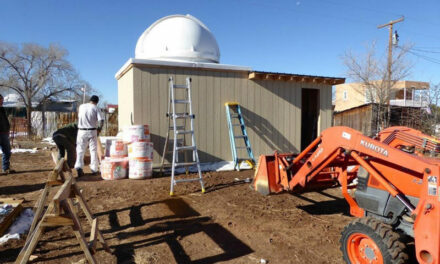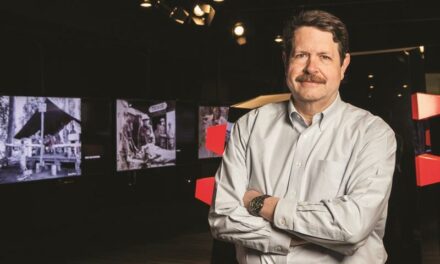Inside a building in Magdalena that was built as a church and later converted into the village’s Senior Center, youngsters congregate to learn science and find inspiration from a variety of after-school activities.
Going on for four years, the Kids’ Science Cafe offers youth something fun – and educational – to do during their non-school Fridays. A retired U.S. Army captain, former science teacher Jim Sauer, and a cadre of dedicated volunteers began the program based on the simple principle that science can be fun.
On any typical Friday morning, Sauer supervises the kids in learning about chemistry, engineering, aeronautics, electrical engineering, robotics and astronomy. In the afternoon, it’s computer coding at the public library, overseen by librarian Ivy Stover.
“We’re still cooking along, and by and large, we’re still the same organization,” Sauer said last week. “For a while there with the COVID, the teens stopped coming. Not only that, but the boys and girls, you know, have volleyball, basketball, track, and everything else connected with extracurricular activities. Right now, we’re building up our membership again.”
Depending on the weekend, between nine and 12 kids will show up, he said,
“We still run a six-hour format with those kids on Fridays, from 10 in the morning till four in the afternoon,” Sauer said. “With the younger kids, it’s a two-hour format. From 10 until noon, they have a project. After lunch, we take the kids to the library. Miss Ivy likes working with them on coding and programming.
“The last two hours had been art, but that program ran out of funding, and so we’re using that block for an archaeology program,” he said.
Sauer has secured permission from Richard Torres to use the vacant lot on North Main Street between the old Mountain Mail building and the Evett’s building for the archaeological project.
“Back in 1880, that used to be a livery stable,” he said. “The kids have gotten permission from Richard Torres to do an archaeological survey on that site using metal detectors, pointed trowels, tools like that.”
The archaeology program will begin in the coming weeks.

The Magdalena Teen Science Cafe’ works with New Mexico Tech Geology Department Water Project. They will present on April 20 about their findings.
Photos by Tristan Alvarez
“We hope there will be a little bit of frontier history that comes out of that,” Sauer said. “Being a livery stable, you know, there’s going to be bits and pieces and shards of metal. The metal detector they acquired is nice, so they should be able to tell the difference between something that’s brass, something that’s copper, and so on. If we’re lucky, maybe we’ll find a penny or two. In which case, it will probably be one of the old Indian head bronze coins. If we’re really lucky, someone would’ve left us a silver nickel or silver dime.”
He said the kids will sweep the lot with the detectors first, mark with survey flags each spot they get a metal reading, and then use pointed trowels to unearth the find.
“There was one picture from the 1880s, and of course, that whole space was the livery stable itself,” Sauer said. “Then, from 1910 to 1915, half of that livery stable was gone, but you can tell there was an outhouse out there. And so the kids were wondering what we would find in there. One youngster said his mom dropped her cell phone in the toilet. He said, ‘Maybe we’ll find one in there.’”
It’s all about teaching them skills, Sauer said, “and them wanting to investigate stuff.”
Well water analysis is an ongoing project for teens in concert with the Bureau of Geology.
“(New Mexico) Tech reached out to us and said do you have any teens who want to do water analysis,” Sauer said. “My kids were hot on it. We picked up a water quality test kit through a Ted Turner grant. They use electronic sensing equipment to test things like pH and hardness. We look at phosphates and nitrates in the water. We’ll look at oxygen content. CO2 content.
“They’ve been collecting water samples from the different ranches in the area,” he said. “As you know, if you live in the city, the Environmental Department keeps track of a municipality’s water quality, but they don’t do any of that stuff for the ranchers.”
Basic chemical analysis on water samples from the ranchers’ wells is conducted in the field, and further tests are done in the lab.
“They run specific tests on 12 different metals that do not work friendly with people,” Sauer said. “And the kids will go back out there to the ranchers and say, here’s your water. Here’s what’s in it.”
Geochemist Bonnie Frey at the New Mexico Bureau of Geology and Mineral Resources is instrumental in overseeing the program, made possible by a grant from the National Science Foundation.

Members of the Magdalena Teen Science Cafe’ enter water sample data as part of the New Mexico Tech Water Project.
“Part of the grant is intended to support the outreach program, the NMT Water Resources Education Program, to educate high school students about their local water resources,” said Frey, the lab manager, in an interview last year. “Our spectrometer is especially suited for running metal analysis. The Optical Emission Spectrometer allows us to work with samples high in phosphates or rare-earth elements without much sample prep.”
The funding for the outreach program is for the two-year period ending in August 2023. The intention is to find more funding to turn it into a long-term program to continue collaborations with the high schools.
Sauer said the Magdalena teens working on the New Mexico Geological Society Abstract for the New Mexico Tech Water Education Project are taking water samples from 10 wide-reaching sites, from stock tanks to private wells, and they will be presenting their research and findings at a meeting at the Bureau of Geology on April 20.
“They wanted our kids to present, and we’re the only middle schoolers in the state of New Mexico participating in this water program,” he said. “These kids, at the end of this two-year program, are probably going to have in the neighborhood of 40 hours of outdoor research, using chemistry and learning the equipment.”
Other programs in the works for Science Cafe members include structural engineering involving bridge building, robotics patterned after JPL’s Mars robot, and astronomy using the backyard observatory on the property.
“Those are hands-on classes,” he said. “They’re also learning how to make and launch weather balloons and how to build meteorological rockets.”
Sauer also holds a geoscience course for the kids, featuring trips to Langmuir Lightning Lab on South Baldy Mountain.
“I take six kids up there every summer. Three boys and three girls,” he said. “I run it through the physics department at New Mexico Tech.”
Other activities include aviation camps at Kirtland Air Force Base the first full week of June and the third full week of June.
“And again, it’s for the kids,” Sauer said. “All our summer programs are free to them. Don’t charge a dime for them. The important thing is to get kids interested in science and engineering.”


















